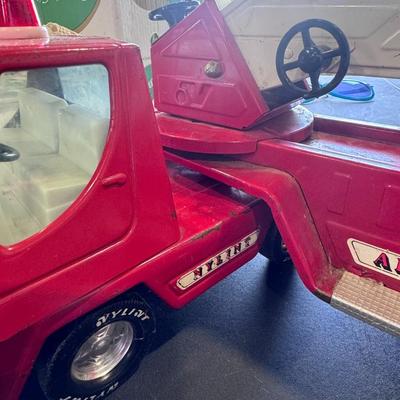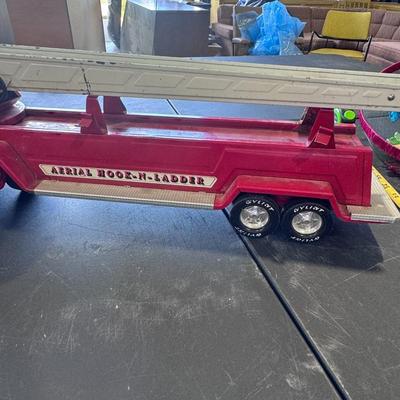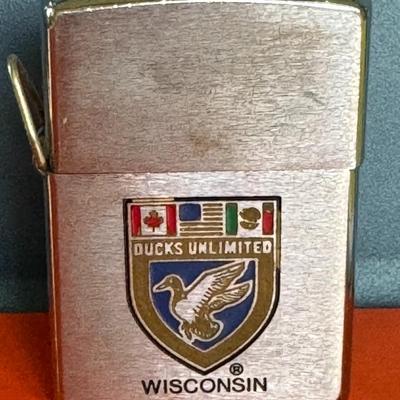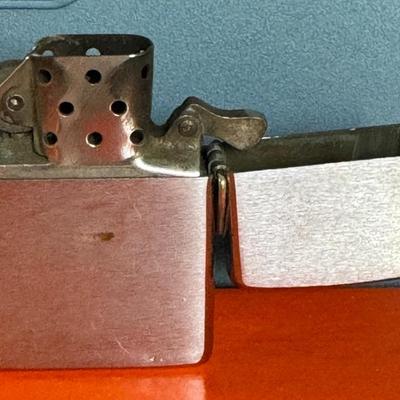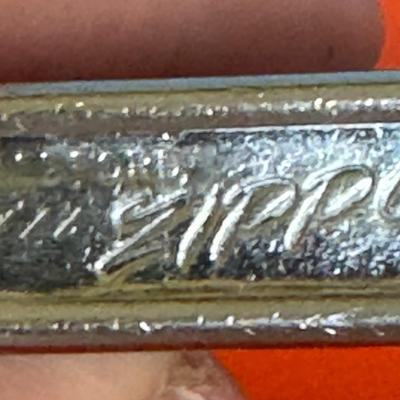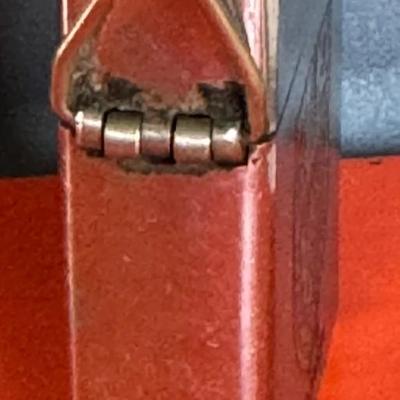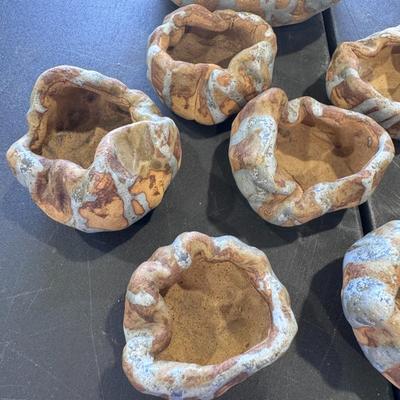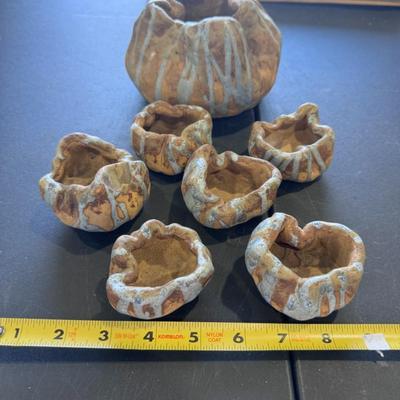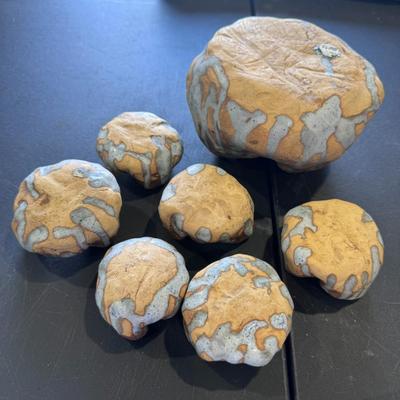-
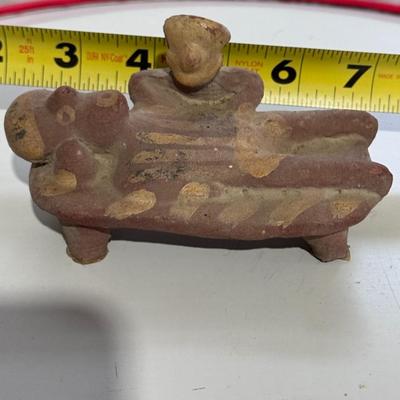
The image shows a Pre-Columbian style Nayarit ceramic figure, likely from West Mexico (modern-day Nayarit state). These figures are characteristic of the Late Formative and Early Classic periods, roughly dating from 300 BCE to 450 CE. Key details about Nayarit ceramic figures: Cultural Significance: These figures were often found in shaft tombs and offer insights into the daily and ritual life of the ancient Nayarit people, depicting scenes like feasts, ballgames, and family life. Materials and Style: Typically made from terracotta or burnished ceramic, they often feature painted and incised details. The figure in your image, with a caretaker seated beside another figure on a bed, is a common subject found in this style. Dimensions: Based on the visible measuring tape, the figure is approximately 4.5 inches (11.4 cm) in length. 503 / 1369 -
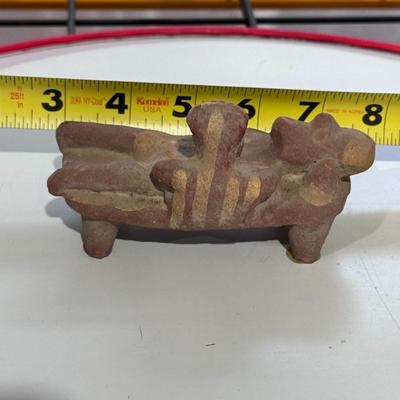
The image shows a Pre-Columbian style Nayarit ceramic figure, likely from West Mexico (modern-day Nayarit state). These figures are characteristic of the Late Formative and Early Classic periods, roughly dating from 300 BCE to 450 CE. Key details about Nayarit ceramic figures: Cultural Significance: These figures were often found in shaft tombs and offer insights into the daily and ritual life of the ancient Nayarit people, depicting scenes like feasts, ballgames, and family life. Materials and Style: Typically made from terracotta or burnished ceramic, they often feature painted and incised details. The figure in your image, with a caretaker seated beside another figure on a bed, is a common subject found in this style. Dimensions: Based on the visible measuring tape, the figure is approximately 4.5 inches (11.4 cm) in length. 504 / 1369 -
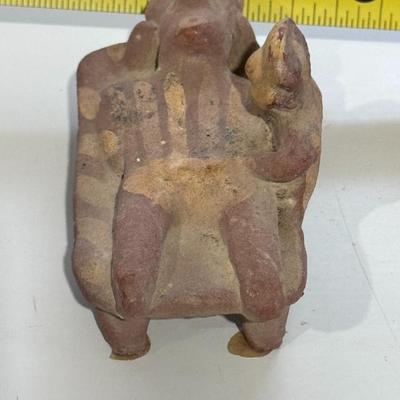
The image shows a Pre-Columbian style Nayarit ceramic figure, likely from West Mexico (modern-day Nayarit state). These figures are characteristic of the Late Formative and Early Classic periods, roughly dating from 300 BCE to 450 CE. Key details about Nayarit ceramic figures: Cultural Significance: These figures were often found in shaft tombs and offer insights into the daily and ritual life of the ancient Nayarit people, depicting scenes like feasts, ballgames, and family life. Materials and Style: Typically made from terracotta or burnished ceramic, they often feature painted and incised details. The figure in your image, with a caretaker seated beside another figure on a bed, is a common subject found in this style. Dimensions: Based on the visible measuring tape, the figure is approximately 4.5 inches (11.4 cm) in length. 505 / 1369 -
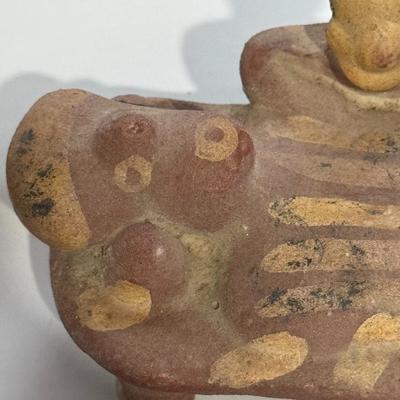
The image shows a Pre-Columbian style Nayarit ceramic figure, likely from West Mexico (modern-day Nayarit state). These figures are characteristic of the Late Formative and Early Classic periods, roughly dating from 300 BCE to 450 CE. Key details about Nayarit ceramic figures: Cultural Significance: These figures were often found in shaft tombs and offer insights into the daily and ritual life of the ancient Nayarit people, depicting scenes like feasts, ballgames, and family life. Materials and Style: Typically made from terracotta or burnished ceramic, they often feature painted and incised details. The figure in your image, with a caretaker seated beside another figure on a bed, is a common subject found in this style. Dimensions: Based on the visible measuring tape, the figure is approximately 4.5 inches (11.4 cm) in length. 506 / 1369 -
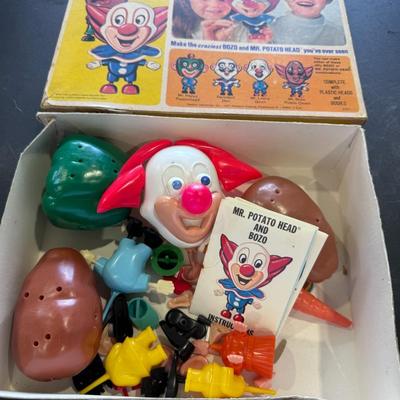
box isnt in the best shape 507 / 1369 -

box isnt in the best shape 508 / 1369 -
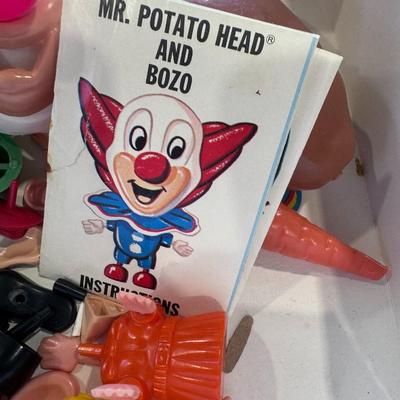
box isnt in the best shape 509 / 1369 -
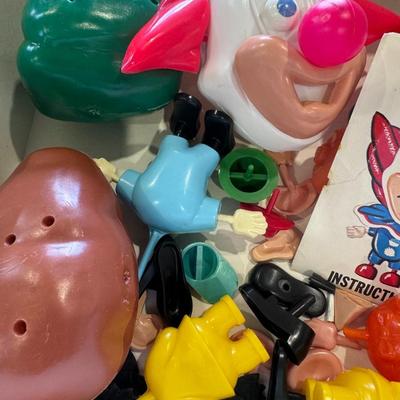
box isnt in the best shape 510 / 1369 -

box isnt in the best shape 511 / 1369 -

box isnt in the best shape 512 / 1369 -
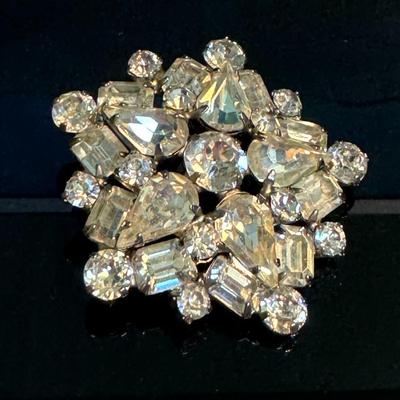
Vintage Weiss Clear Rhinestone Brooch Pin, likely from the mid-20th century. Here's more information about this type of piece: Brand: It is signed "Weiss," referring to Albert Weiss & Co., a costume jewelry company founded in 1942 and active until 1971. Design: The brooch features a cluster of clear rhinestones in various shapes and sizes, often arranged in a star or floral/starburst pattern within a silver-toned setting. Materials: These pieces typically use high-quality clear crystal rhinestones, often faceted for maximum sparkle, set in a silver-tone metal base. Collectibility: Weiss brooches, especially those with intricate designs and in good condition, are popular among collectors of vintage costume jewelry 513 / 1369 -
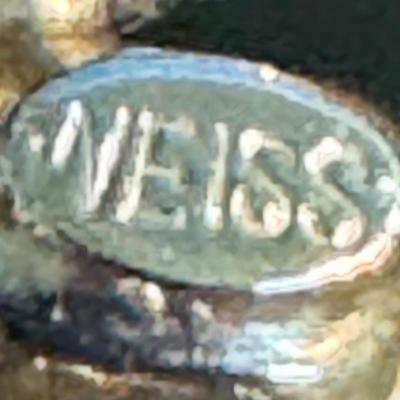
Vintage Weiss Clear Rhinestone Brooch Pin, likely from the mid-20th century. Here's more information about this type of piece: Brand: It is signed "Weiss," referring to Albert Weiss & Co., a costume jewelry company founded in 1942 and active until 1971. Design: The brooch features a cluster of clear rhinestones in various shapes and sizes, often arranged in a star or floral/starburst pattern within a silver-toned setting. Materials: These pieces typically use high-quality clear crystal rhinestones, often faceted for maximum sparkle, set in a silver-tone metal base. Collectibility: Weiss brooches, especially those with intricate designs and in good condition, are popular among collectors of vintage costume jewelry 514 / 1369 -
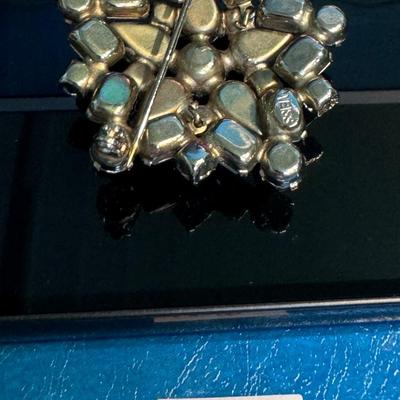
Vintage Weiss Clear Rhinestone Brooch Pin, likely from the mid-20th century. Here's more information about this type of piece: Brand: It is signed "Weiss," referring to Albert Weiss & Co., a costume jewelry company founded in 1942 and active until 1971. Design: The brooch features a cluster of clear rhinestones in various shapes and sizes, often arranged in a star or floral/starburst pattern within a silver-toned setting. Materials: These pieces typically use high-quality clear crystal rhinestones, often faceted for maximum sparkle, set in a silver-tone metal base. Collectibility: Weiss brooches, especially those with intricate designs and in good condition, are popular among collectors of vintage costume jewelry 515 / 1369 -
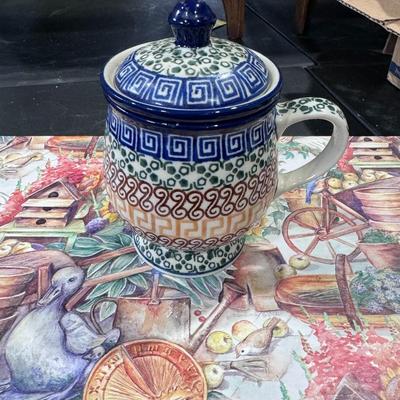
Polish Pottery Brewing Mug, specifically identified as an Autumn Tea Infusion Mug in the "Autumn (50)" pattern from the Ceramika Artystyczna factory. Here's more information about this type of pottery and mug: Origin and Craftsmanship: Polish Pottery, including this mug, is handcrafted and hand-painted in Boleslawiec, Poland, a region renowned for its stoneware tradition. Each piece is a unique work of art, often signed by the artist if it's an "Unikat" (Signature) piece, which denotes more intricate designs. Design and Pattern: This mug features a classic design with distinct patterns, including the prominent blue Greek Key border and the characteristic "Autumn (50)" pattern on the body, which adds to its decorative appeal. The design is reflective of traditional Polish pottery aesthetics. Functionality: Designed as a brewing or infusion mug, it typically includes a lid to help steep and keep beverages warm, making it ideal for brewing tea or other infusions. 516 / 1369 -
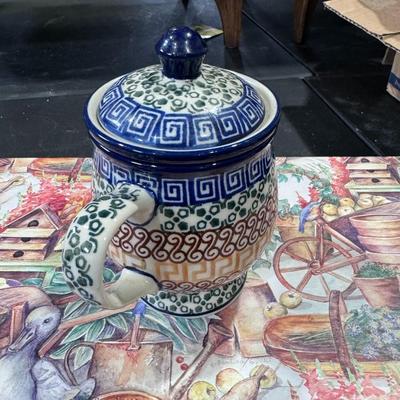
Polish Pottery Brewing Mug, specifically identified as an Autumn Tea Infusion Mug in the "Autumn (50)" pattern from the Ceramika Artystyczna factory. Here's more information about this type of pottery and mug: Origin and Craftsmanship: Polish Pottery, including this mug, is handcrafted and hand-painted in Boleslawiec, Poland, a region renowned for its stoneware tradition. Each piece is a unique work of art, often signed by the artist if it's an "Unikat" (Signature) piece, which denotes more intricate designs. Design and Pattern: This mug features a classic design with distinct patterns, including the prominent blue Greek Key border and the characteristic "Autumn (50)" pattern on the body, which adds to its decorative appeal. The design is reflective of traditional Polish pottery aesthetics. Functionality: Designed as a brewing or infusion mug, it typically includes a lid to help steep and keep beverages warm, making it ideal for brewing tea or other infusions. 517 / 1369 -
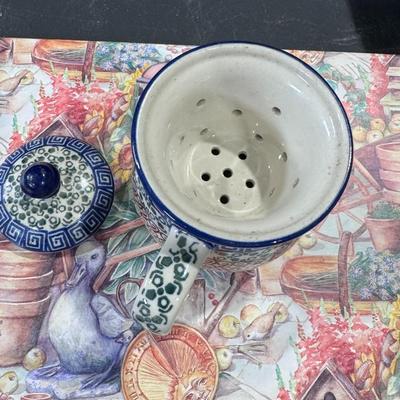
Polish Pottery Brewing Mug, specifically identified as an Autumn Tea Infusion Mug in the "Autumn (50)" pattern from the Ceramika Artystyczna factory. Here's more information about this type of pottery and mug: Origin and Craftsmanship: Polish Pottery, including this mug, is handcrafted and hand-painted in Boleslawiec, Poland, a region renowned for its stoneware tradition. Each piece is a unique work of art, often signed by the artist if it's an "Unikat" (Signature) piece, which denotes more intricate designs. Design and Pattern: This mug features a classic design with distinct patterns, including the prominent blue Greek Key border and the characteristic "Autumn (50)" pattern on the body, which adds to its decorative appeal. The design is reflective of traditional Polish pottery aesthetics. Functionality: Designed as a brewing or infusion mug, it typically includes a lid to help steep and keep beverages warm, making it ideal for brewing tea or other infusions. 518 / 1369 -
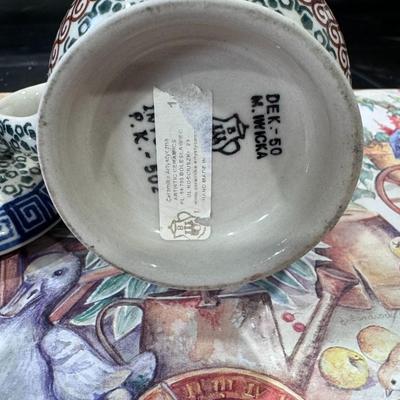
Polish Pottery Brewing Mug, specifically identified as an Autumn Tea Infusion Mug in the "Autumn (50)" pattern from the Ceramika Artystyczna factory. Here's more information about this type of pottery and mug: Origin and Craftsmanship: Polish Pottery, including this mug, is handcrafted and hand-painted in Boleslawiec, Poland, a region renowned for its stoneware tradition. Each piece is a unique work of art, often signed by the artist if it's an "Unikat" (Signature) piece, which denotes more intricate designs. Design and Pattern: This mug features a classic design with distinct patterns, including the prominent blue Greek Key border and the characteristic "Autumn (50)" pattern on the body, which adds to its decorative appeal. The design is reflective of traditional Polish pottery aesthetics. Functionality: Designed as a brewing or infusion mug, it typically includes a lid to help steep and keep beverages warm, making it ideal for brewing tea or other infusions. 519 / 1369 -
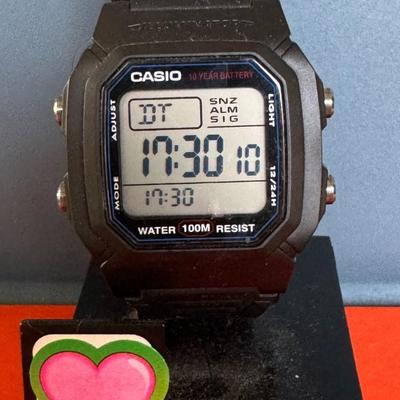
The image shows a Casio W-800H watch with its display indicating "DT" and two time settings: 17:30 This indicates that the watch is in Dual Time (DT) mode, which allows you to keep track of the time in two different time zones. Here's a summary of the watch's features based on the image and supporting search results: Dual Time: The "DT" on the display signifies that the dual time function is active, allowing the user to view the time in two zones simultaneously. Time Display: The primary time displayed is 17:30, and the second time in the other time zone is 10:30. 10-Year Battery: The watch features a 10-year battery life, powered by a CR2025 battery. Water Resistance: The watch is water-resistant up to 100 meters, making it suitable for swimming and snorkeling. LED Backlight: It includes an LED backlight for visibility in low-light conditions. Other Features: The watch also includes a stopwatch, a multi-function alarm (with snooze), an hourly time signal, and a full auto-calendar (preprogrammed until 2099). Display: It displays the day of the week, year, month, and date on the screen. Size and Weight: The case measures 44.2 × 36.8 × 13.4 mm and weighs 37g. 520 / 1369 -
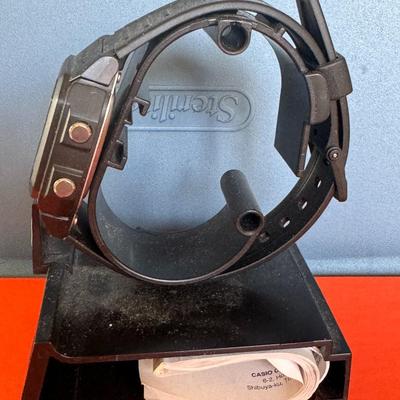
The image shows a Casio W-800H watch with its display indicating "DT" and two time settings: 17:30 This indicates that the watch is in Dual Time (DT) mode, which allows you to keep track of the time in two different time zones. Here's a summary of the watch's features based on the image and supporting search results: Dual Time: The "DT" on the display signifies that the dual time function is active, allowing the user to view the time in two zones simultaneously. Time Display: The primary time displayed is 17:30, and the second time in the other time zone is 10:30. 10-Year Battery: The watch features a 10-year battery life, powered by a CR2025 battery. Water Resistance: The watch is water-resistant up to 100 meters, making it suitable for swimming and snorkeling. LED Backlight: It includes an LED backlight for visibility in low-light conditions. Other Features: The watch also includes a stopwatch, a multi-function alarm (with snooze), an hourly time signal, and a full auto-calendar (preprogrammed until 2099). Display: It displays the day of the week, year, month, and date on the screen. Size and Weight: The case measures 44.2 × 36.8 × 13.4 mm and weighs 37g. 521 / 1369 -
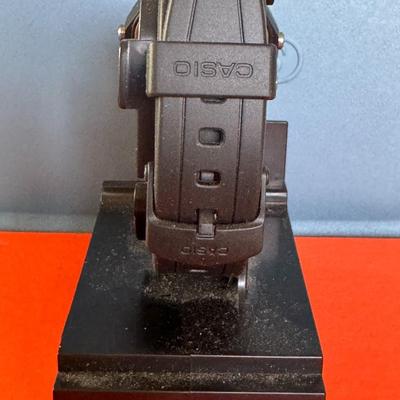
The image shows a Casio W-800H watch with its display indicating "DT" and two time settings: 17:30 This indicates that the watch is in Dual Time (DT) mode, which allows you to keep track of the time in two different time zones. Here's a summary of the watch's features based on the image and supporting search results: Dual Time: The "DT" on the display signifies that the dual time function is active, allowing the user to view the time in two zones simultaneously. Time Display: The primary time displayed is 17:30, and the second time in the other time zone is 10:30. 10-Year Battery: The watch features a 10-year battery life, powered by a CR2025 battery. Water Resistance: The watch is water-resistant up to 100 meters, making it suitable for swimming and snorkeling. LED Backlight: It includes an LED backlight for visibility in low-light conditions. Other Features: The watch also includes a stopwatch, a multi-function alarm (with snooze), an hourly time signal, and a full auto-calendar (preprogrammed until 2099). Display: It displays the day of the week, year, month, and date on the screen. Size and Weight: The case measures 44.2 × 36.8 × 13.4 mm and weighs 37g. 522 / 1369 -
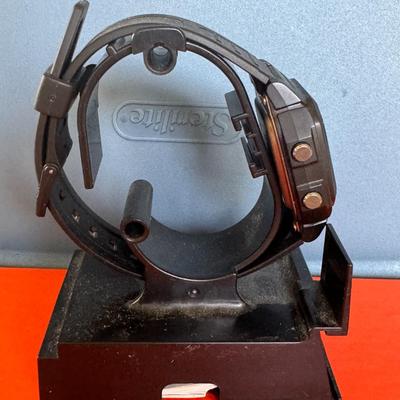
The image shows a Casio W-800H watch with its display indicating "DT" and two time settings: 17:30 This indicates that the watch is in Dual Time (DT) mode, which allows you to keep track of the time in two different time zones. Here's a summary of the watch's features based on the image and supporting search results: Dual Time: The "DT" on the display signifies that the dual time function is active, allowing the user to view the time in two zones simultaneously. Time Display: The primary time displayed is 17:30, and the second time in the other time zone is 10:30. 10-Year Battery: The watch features a 10-year battery life, powered by a CR2025 battery. Water Resistance: The watch is water-resistant up to 100 meters, making it suitable for swimming and snorkeling. LED Backlight: It includes an LED backlight for visibility in low-light conditions. Other Features: The watch also includes a stopwatch, a multi-function alarm (with snooze), an hourly time signal, and a full auto-calendar (preprogrammed until 2099). Display: It displays the day of the week, year, month, and date on the screen. Size and Weight: The case measures 44.2 × 36.8 × 13.4 mm and weighs 37g. 523 / 1369 -
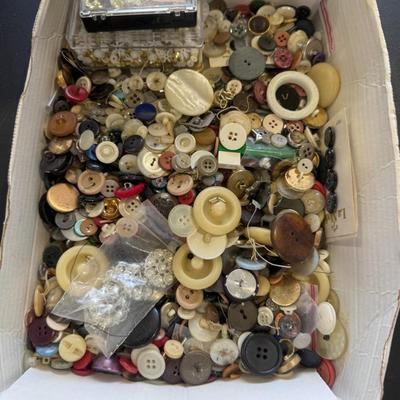
Large box of vintage buttons, mixed 524 / 1369 -
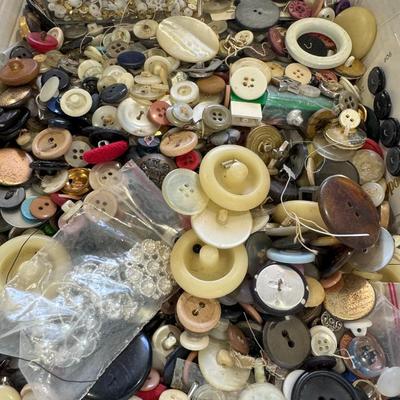
Large box of vintage buttons, mixed 525 / 1369 -
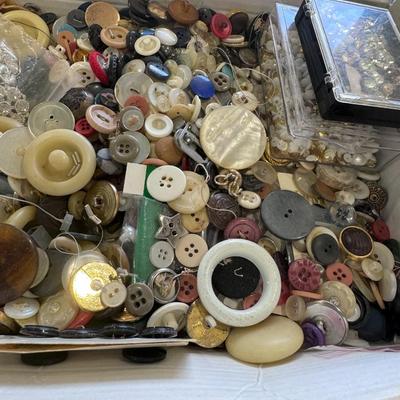
Large box of vintage buttons, mixed 526 / 1369 -
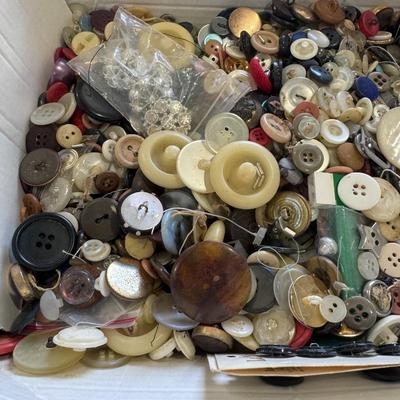
Large box of vintage buttons, mixed 527 / 1369 -
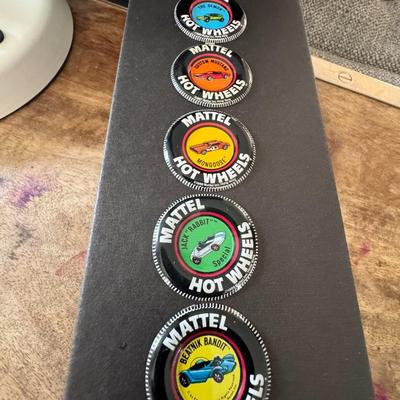
produced by Mattel alongside their iconic die-cast cars during the Key information about these collector buttons: Origin and Purpose: These metal (or later, plastic) buttons were originally included with Hot Wheels cars as a marketing tool, intended to encourage child-to-child interaction and promote the different car models. Era: The buttons shown are from the initial "Redline" period, recognizable by their distinct red-striped wheels on the associated die-cast cars. Variations: Material: Early buttons were metal, while later versions (from 1971) were plastic, likely for safety reasons. 528 / 1369 -
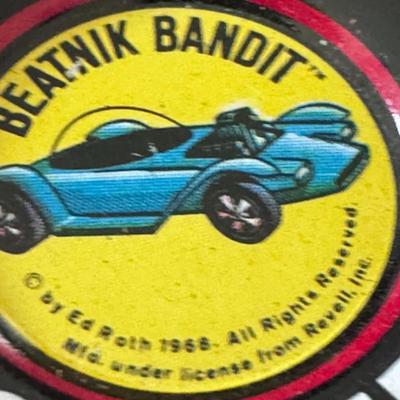
produced by Mattel alongside their iconic die-cast cars during the Key information about these collector buttons: Origin and Purpose: These metal (or later, plastic) buttons were originally included with Hot Wheels cars as a marketing tool, intended to encourage child-to-child interaction and promote the different car models. Era: The buttons shown are from the initial "Redline" period, recognizable by their distinct red-striped wheels on the associated die-cast cars. Variations: Material: Early buttons were metal, while later versions (from 1971) were plastic, likely for safety reasons. 529 / 1369 -
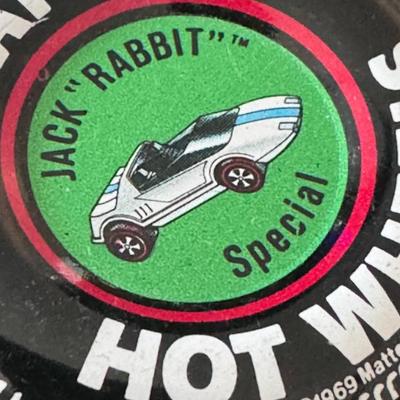
produced by Mattel alongside their iconic die-cast cars during the Key information about these collector buttons: Origin and Purpose: These metal (or later, plastic) buttons were originally included with Hot Wheels cars as a marketing tool, intended to encourage child-to-child interaction and promote the different car models. Era: The buttons shown are from the initial "Redline" period, recognizable by their distinct red-striped wheels on the associated die-cast cars. Variations: Material: Early buttons were metal, while later versions (from 1971) were plastic, likely for safety reasons. 530 / 1369 -
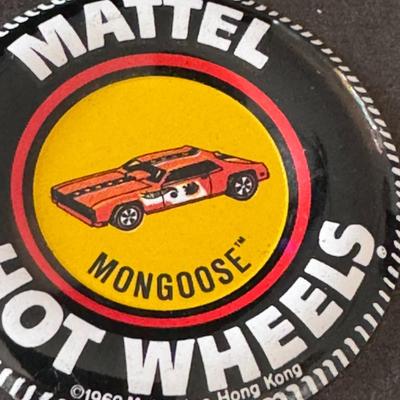
produced by Mattel alongside their iconic die-cast cars during the Key information about these collector buttons: Origin and Purpose: These metal (or later, plastic) buttons were originally included with Hot Wheels cars as a marketing tool, intended to encourage child-to-child interaction and promote the different car models. Era: The buttons shown are from the initial "Redline" period, recognizable by their distinct red-striped wheels on the associated die-cast cars. Variations: Material: Early buttons were metal, while later versions (from 1971) were plastic, likely for safety reasons. 531 / 1369 -

produced by Mattel alongside their iconic die-cast cars during the Key information about these collector buttons: Origin and Purpose: These metal (or later, plastic) buttons were originally included with Hot Wheels cars as a marketing tool, intended to encourage child-to-child interaction and promote the different car models. Era: The buttons shown are from the initial "Redline" period, recognizable by their distinct red-striped wheels on the associated die-cast cars. Variations: Material: Early buttons were metal, while later versions (from 1971) were plastic, likely for safety reasons. 532 / 1369 -
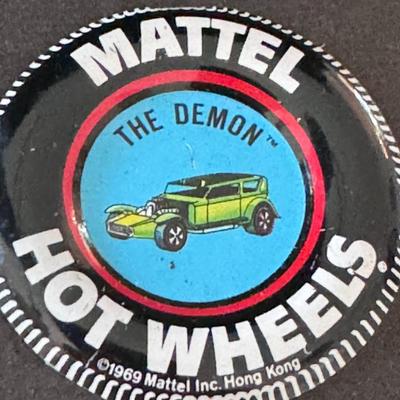
produced by Mattel alongside their iconic die-cast cars during the Key information about these collector buttons: Origin and Purpose: These metal (or later, plastic) buttons were originally included with Hot Wheels cars as a marketing tool, intended to encourage child-to-child interaction and promote the different car models. Era: The buttons shown are from the initial "Redline" period, recognizable by their distinct red-striped wheels on the associated die-cast cars. Variations: Material: Early buttons were metal, while later versions (from 1971) were plastic, likely for safety reasons. 533 / 1369 -
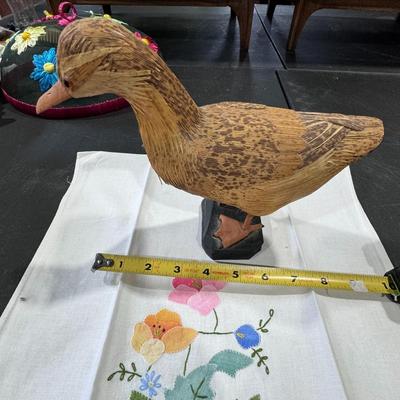
Material and Construction: Corn husk ducks are created by shaping and layering dried corn husks, often over a base or core, and then drying them to hold their form. Some may incorporate other natural materials like reeds or cork. Folk Art and Decoy: While they can serve as decorative folk art pieces, some corn husk ducks were also made as lightweight decoys for hunting waterfowl. 534 / 1369 -
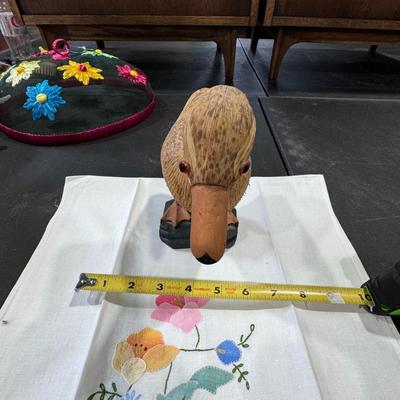
Material and Construction: Corn husk ducks are created by shaping and layering dried corn husks, often over a base or core, and then drying them to hold their form. Some may incorporate other natural materials like reeds or cork. Folk Art and Decoy: While they can serve as decorative folk art pieces, some corn husk ducks were also made as lightweight decoys for hunting waterfowl. 535 / 1369 -
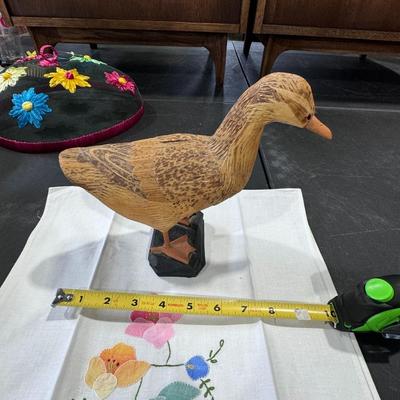
Material and Construction: Corn husk ducks are created by shaping and layering dried corn husks, often over a base or core, and then drying them to hold their form. Some may incorporate other natural materials like reeds or cork. Folk Art and Decoy: While they can serve as decorative folk art pieces, some corn husk ducks were also made as lightweight decoys for hunting waterfowl. 536 / 1369 -
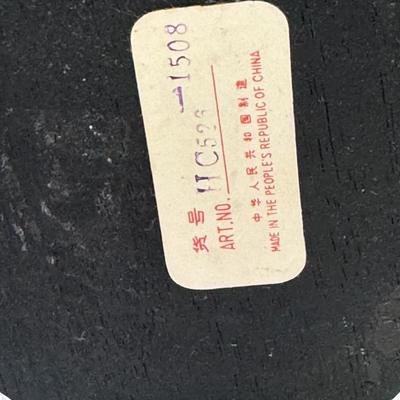
Material and Construction: Corn husk ducks are created by shaping and layering dried corn husks, often over a base or core, and then drying them to hold their form. Some may incorporate other natural materials like reeds or cork. Folk Art and Decoy: While they can serve as decorative folk art pieces, some corn husk ducks were also made as lightweight decoys for hunting waterfowl. 537 / 1369 -
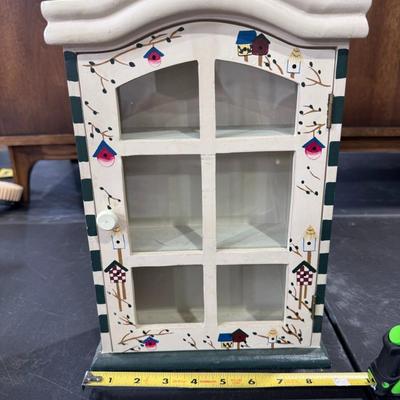
Purpose: It's designed to display small collectibles, figurines, or other decorative items on its interior shelves. Features: It typically includes multiple shelves for organization and a glass door to protect the items while still allowing them to be viewed. Placement: This type of cabinet can be either wall-mounted or placed on a tabletop or other flat surface. Style: The one pictured has a vintage or farmhouse aesthetic with a rounded top and a distressed or painted finish 538 / 1369 -
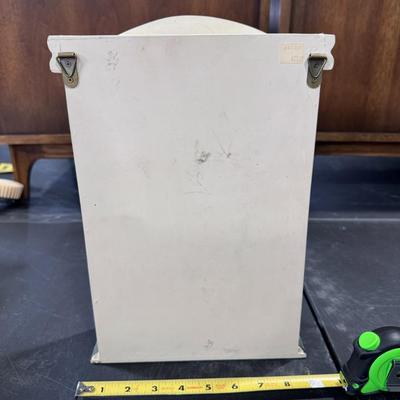
Purpose: It's designed to display small collectibles, figurines, or other decorative items on its interior shelves. Features: It typically includes multiple shelves for organization and a glass door to protect the items while still allowing them to be viewed. Placement: This type of cabinet can be either wall-mounted or placed on a tabletop or other flat surface. Style: The one pictured has a vintage or farmhouse aesthetic with a rounded top and a distressed or painted finish 539 / 1369 -
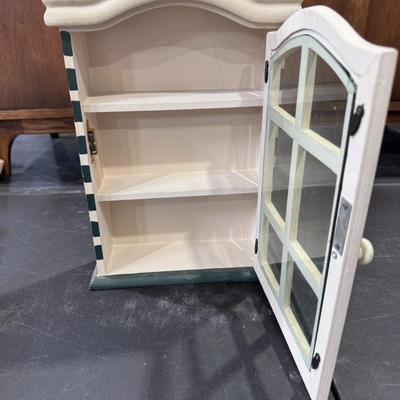
Purpose: It's designed to display small collectibles, figurines, or other decorative items on its interior shelves. Features: It typically includes multiple shelves for organization and a glass door to protect the items while still allowing them to be viewed. Placement: This type of cabinet can be either wall-mounted or placed on a tabletop or other flat surface. Style: The one pictured has a vintage or farmhouse aesthetic with a rounded top and a distressed or painted finish 540 / 1369 -
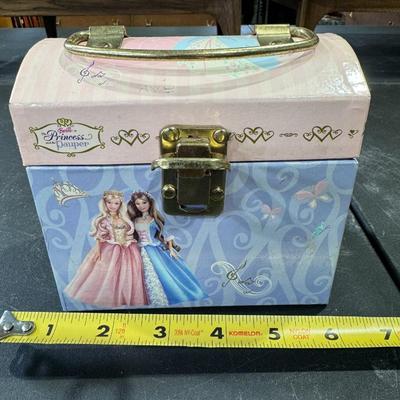
Barbie as The Princess and the Pauper Storage Trunk from 2004. Here's more information about this item: Product Type: It served as a storage trunk or carrying case for Barbie dolls and accessories, and some versions also functioned as musical jewelry boxes playing tunes from the movie. Theme: The trunk features artwork and branding from the animated movie Barbie as The Princess and the Pauper, released in 2004. Collectibility: As a vintage piece of Barbie movie merchandise, these trunks can be collectible, particularly in good condition, and may hold value among collectors. Dimensions: While the image shows a tape measure indicating its size, typical musical jewelry boxes or doll trunks of this type are around 6 inches in length, 4.1 inches in width, and similar in height. 541 / 1369 -
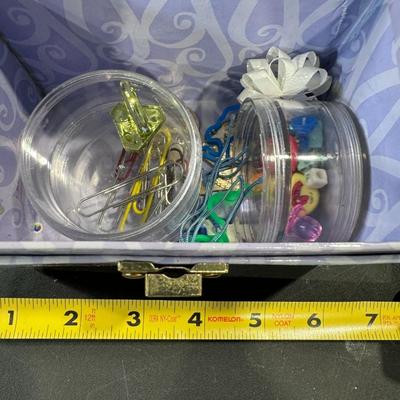
Barbie as The Princess and the Pauper Storage Trunk from 2004. Here's more information about this item: Product Type: It served as a storage trunk or carrying case for Barbie dolls and accessories, and some versions also functioned as musical jewelry boxes playing tunes from the movie. Theme: The trunk features artwork and branding from the animated movie Barbie as The Princess and the Pauper, released in 2004. Collectibility: As a vintage piece of Barbie movie merchandise, these trunks can be collectible, particularly in good condition, and may hold value among collectors. Dimensions: While the image shows a tape measure indicating its size, typical musical jewelry boxes or doll trunks of this type are around 6 inches in length, 4.1 inches in width, and similar in height. 542 / 1369 -
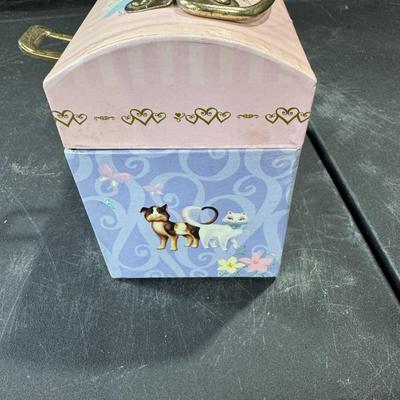
Barbie as The Princess and the Pauper Storage Trunk from 2004. Here's more information about this item: Product Type: It served as a storage trunk or carrying case for Barbie dolls and accessories, and some versions also functioned as musical jewelry boxes playing tunes from the movie. Theme: The trunk features artwork and branding from the animated movie Barbie as The Princess and the Pauper, released in 2004. Collectibility: As a vintage piece of Barbie movie merchandise, these trunks can be collectible, particularly in good condition, and may hold value among collectors. Dimensions: While the image shows a tape measure indicating its size, typical musical jewelry boxes or doll trunks of this type are around 6 inches in length, 4.1 inches in width, and similar in height. 543 / 1369 -
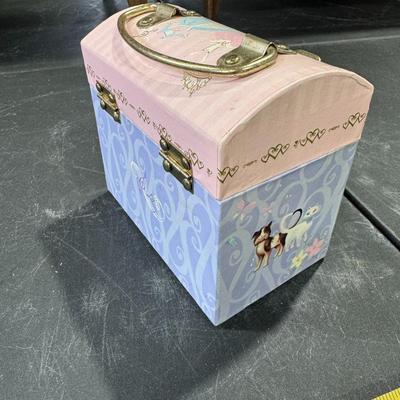
Barbie as The Princess and the Pauper Storage Trunk from 2004. Here's more information about this item: Product Type: It served as a storage trunk or carrying case for Barbie dolls and accessories, and some versions also functioned as musical jewelry boxes playing tunes from the movie. Theme: The trunk features artwork and branding from the animated movie Barbie as The Princess and the Pauper, released in 2004. Collectibility: As a vintage piece of Barbie movie merchandise, these trunks can be collectible, particularly in good condition, and may hold value among collectors. Dimensions: While the image shows a tape measure indicating its size, typical musical jewelry boxes or doll trunks of this type are around 6 inches in length, 4.1 inches in width, and similar in height. 544 / 1369 -
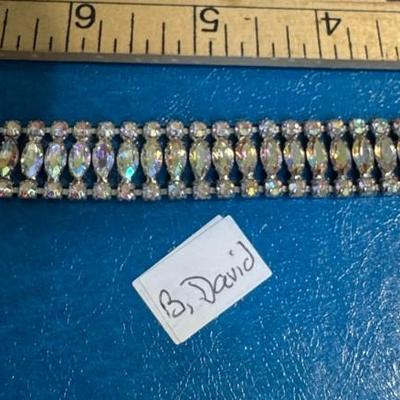
Vintage B. David signed rhinestone bracelet, likely from a collectible costume jewelry line. Here's more information about this type of piece: Designer Background: B. David is known for producing high-quality costume jewelry, often featuring brilliant rhinestones that resemble genuine gemstones, and famously known for their "Family Crown" pins. Design Features: These bracelets commonly feature carefully set rhinestones, often using prong settings, and often include safety chains for added security, as seen in various examples found on marketplaces like Etsy and eBay. Rhinestone Variety: B. David bracelets come with various rhinestone shapes and colors, including clear, AB (Aurora Borealis), and colored rhinestones in different cuts like marquise, round, and baguette. Collectibility: Vintage B. David pieces are often sought after by collectors due to their quality craftsmanship and classic designs, with many pieces available on online marketplaces like Etsy, eBay, and Poshmark. Value: The value can vary significantly based on factors like condition, rarity of the design, and the specific market it's being sold in, but examples can be found ranging from around $30 to over $100 545 / 1369 -

Vintage B. David signed rhinestone bracelet, likely from a collectible costume jewelry line. Here's more information about this type of piece: Designer Background: B. David is known for producing high-quality costume jewelry, often featuring brilliant rhinestones that resemble genuine gemstones, and famously known for their "Family Crown" pins. Design Features: These bracelets commonly feature carefully set rhinestones, often using prong settings, and often include safety chains for added security, as seen in various examples found on marketplaces like Etsy and eBay. Rhinestone Variety: B. David bracelets come with various rhinestone shapes and colors, including clear, AB (Aurora Borealis), and colored rhinestones in different cuts like marquise, round, and baguette. Collectibility: Vintage B. David pieces are often sought after by collectors due to their quality craftsmanship and classic designs, with many pieces available on online marketplaces like Etsy, eBay, and Poshmark. Value: The value can vary significantly based on factors like condition, rarity of the design, and the specific market it's being sold in, but examples can be found ranging from around $30 to over $100 546 / 1369 -
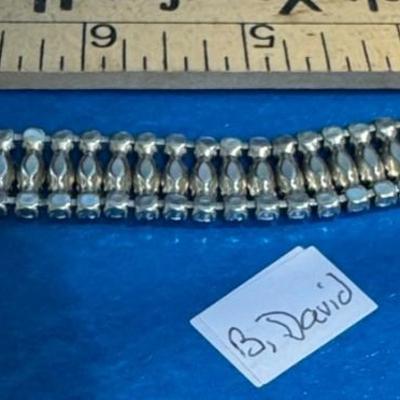
Vintage B. David signed rhinestone bracelet, likely from a collectible costume jewelry line. Here's more information about this type of piece: Designer Background: B. David is known for producing high-quality costume jewelry, often featuring brilliant rhinestones that resemble genuine gemstones, and famously known for their "Family Crown" pins. Design Features: These bracelets commonly feature carefully set rhinestones, often using prong settings, and often include safety chains for added security, as seen in various examples found on marketplaces like Etsy and eBay. Rhinestone Variety: B. David bracelets come with various rhinestone shapes and colors, including clear, AB (Aurora Borealis), and colored rhinestones in different cuts like marquise, round, and baguette. Collectibility: Vintage B. David pieces are often sought after by collectors due to their quality craftsmanship and classic designs, with many pieces available on online marketplaces like Etsy, eBay, and Poshmark. Value: The value can vary significantly based on factors like condition, rarity of the design, and the specific market it's being sold in, but examples can be found ranging from around $30 to over $100 547 / 1369 -
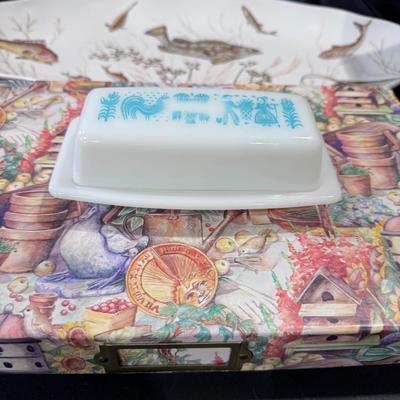
Pyrex "Amish Butterprint" covered butter dish. This collectible piece is made of opal or milk glass and is known for its distinctive turquoise blue pattern featuring an Amish farming scene with a farmer and wife, a rooster, corn, and wheat sheaves. Key details about this item: Pattern: Amish Butterprint (also known as "Butterprint," "Amish," "Farmer & Wife," or "Rooster & Corn"). Color Scheme: Turquoise blue on white opal glass. Material: Milk glass, also referred to as opal glass, which is an opaque white glass first developed in 16th century Venice to mimic porcelain. Collectible Value: These vintage Pyrex pieces, especially those with popular patterns like Butterprint, are sought after by collectors. 548 / 1369 -
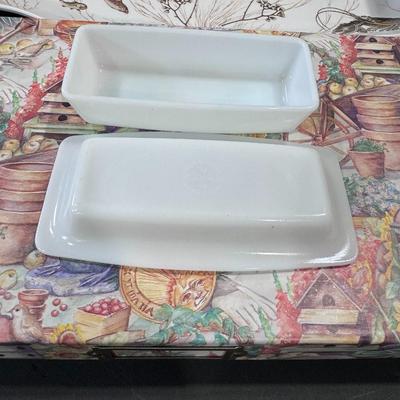
Pyrex "Amish Butterprint" covered butter dish. This collectible piece is made of opal or milk glass and is known for its distinctive turquoise blue pattern featuring an Amish farming scene with a farmer and wife, a rooster, corn, and wheat sheaves. Key details about this item: Pattern: Amish Butterprint (also known as "Butterprint," "Amish," "Farmer & Wife," or "Rooster & Corn"). Color Scheme: Turquoise blue on white opal glass. Material: Milk glass, also referred to as opal glass, which is an opaque white glass first developed in 16th century Venice to mimic porcelain. Collectible Value: These vintage Pyrex pieces, especially those with popular patterns like Butterprint, are sought after by collectors. 549 / 1369 -
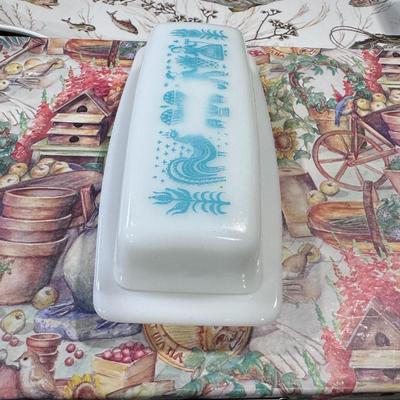
Pyrex "Amish Butterprint" covered butter dish. This collectible piece is made of opal or milk glass and is known for its distinctive turquoise blue pattern featuring an Amish farming scene with a farmer and wife, a rooster, corn, and wheat sheaves. Key details about this item: Pattern: Amish Butterprint (also known as "Butterprint," "Amish," "Farmer & Wife," or "Rooster & Corn"). Color Scheme: Turquoise blue on white opal glass. Material: Milk glass, also referred to as opal glass, which is an opaque white glass first developed in 16th century Venice to mimic porcelain. Collectible Value: These vintage Pyrex pieces, especially those with popular patterns like Butterprint, are sought after by collectors. 550 / 1369 -
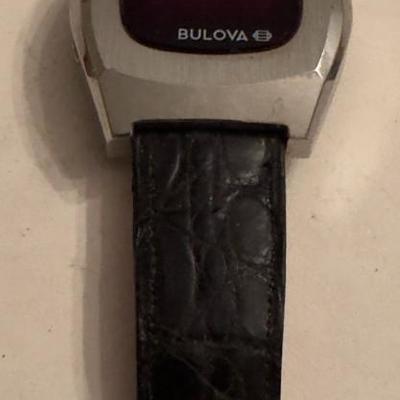
Bulova Computron N6 watch, likely from 1976. This model is considered an early and somewhat underrated example of vintage digital LED watches. Key features and specifications of the Bulova Computron N6: Design: Trapezoidal stainless steel case with a red LED display. Movement: Quartz. Production Year: Circa 1976. Functionality: Originally designed with an angled display to allow easy time-checking for drivers, without needing to turn their wrists. The display shows the time when a button on the side is pressed, and subsequent presses cycle through the date and potentially other information like a second time zone, depending on the model. Later versions had a single button for cycling through these displays. Collectibility: 551 / 1369 -
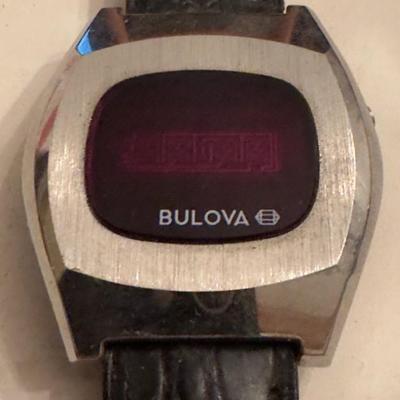
Bulova Computron N6 watch, likely from 1976. This model is considered an early and somewhat underrated example of vintage digital LED watches. Key features and specifications of the Bulova Computron N6: Design: Trapezoidal stainless steel case with a red LED display. Movement: Quartz. Production Year: Circa 1976. Functionality: Originally designed with an angled display to allow easy time-checking for drivers, without needing to turn their wrists. The display shows the time when a button on the side is pressed, and subsequent presses cycle through the date and potentially other information like a second time zone, depending on the model. Later versions had a single button for cycling through these displays. Collectibility: 552 / 1369 -
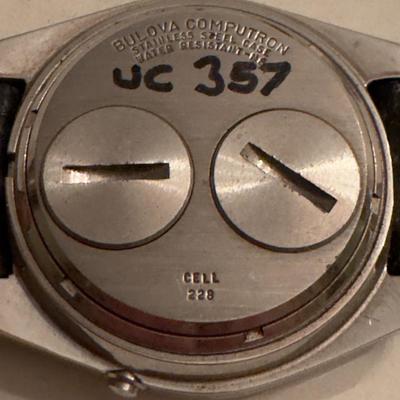
Bulova Computron N6 watch, likely from 1976. This model is considered an early and somewhat underrated example of vintage digital LED watches. Key features and specifications of the Bulova Computron N6: Design: Trapezoidal stainless steel case with a red LED display. Movement: Quartz. Production Year: Circa 1976. Functionality: Originally designed with an angled display to allow easy time-checking for drivers, without needing to turn their wrists. The display shows the time when a button on the side is pressed, and subsequent presses cycle through the date and potentially other information like a second time zone, depending on the model. Later versions had a single button for cycling through these displays. Collectibility: 553 / 1369 -
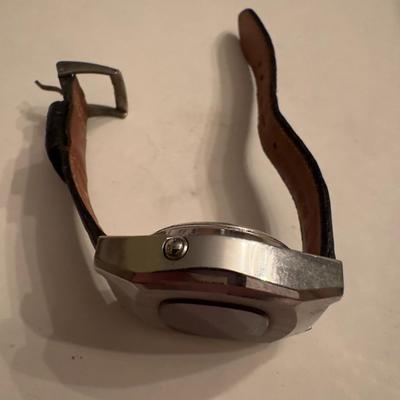
Bulova Computron N6 watch, likely from 1976. This model is considered an early and somewhat underrated example of vintage digital LED watches. Key features and specifications of the Bulova Computron N6: Design: Trapezoidal stainless steel case with a red LED display. Movement: Quartz. Production Year: Circa 1976. Functionality: Originally designed with an angled display to allow easy time-checking for drivers, without needing to turn their wrists. The display shows the time when a button on the side is pressed, and subsequent presses cycle through the date and potentially other information like a second time zone, depending on the model. Later versions had a single button for cycling through these displays. Collectibility: 554 / 1369 -
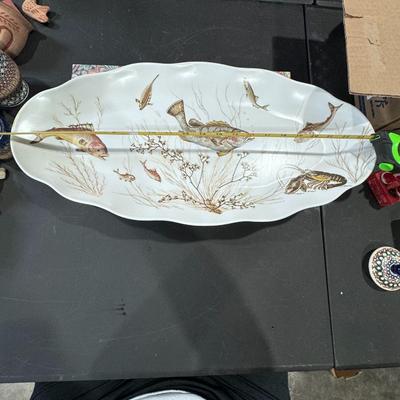
Waverly Products Melamine Fish Platter. Key details about the platter: Brand and Material: It's a vintage platter made by Waverly Products, constructed from melamine, a durable plastic. Design: The platter features an "underwater fresh water fish scene" pattern, also known as "Montage of the Sea," with various fish and aquatic plant motifs. Size: These platters typically measure around 23 inches long. 555 / 1369 -
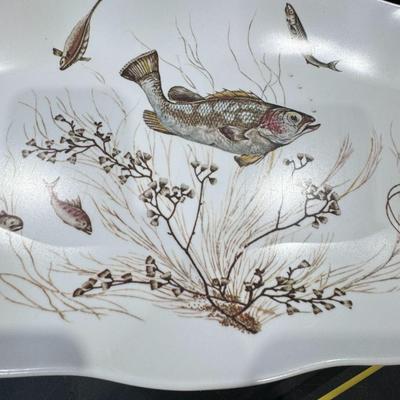
Waverly Products Melamine Fish Platter. Key details about the platter: Brand and Material: It's a vintage platter made by Waverly Products, constructed from melamine, a durable plastic. Design: The platter features an "underwater fresh water fish scene" pattern, also known as "Montage of the Sea," with various fish and aquatic plant motifs. Size: These platters typically measure around 23 inches long. 556 / 1369 -
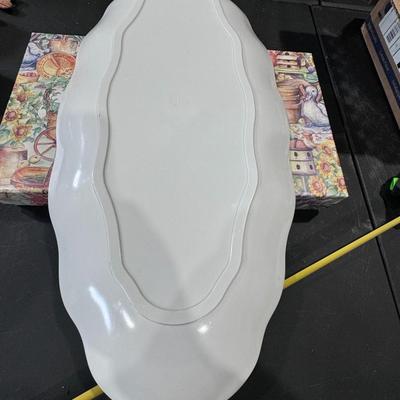
Waverly Products Melamine Fish Platter. Key details about the platter: Brand and Material: It's a vintage platter made by Waverly Products, constructed from melamine, a durable plastic. Design: The platter features an "underwater fresh water fish scene" pattern, also known as "Montage of the Sea," with various fish and aquatic plant motifs. Size: These platters typically measure around 23 inches long. 557 / 1369 -
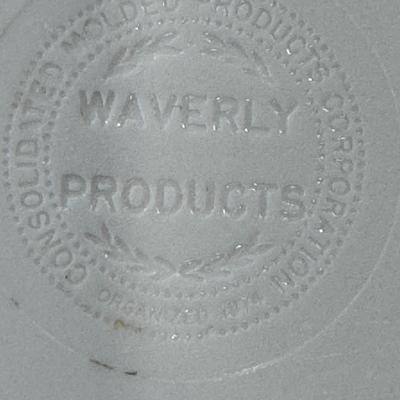
Waverly Products Melamine Fish Platter. Key details about the platter: Brand and Material: It's a vintage platter made by Waverly Products, constructed from melamine, a durable plastic. Design: The platter features an "underwater fresh water fish scene" pattern, also known as "Montage of the Sea," with various fish and aquatic plant motifs. Size: These platters typically measure around 23 inches long. 558 / 1369 -
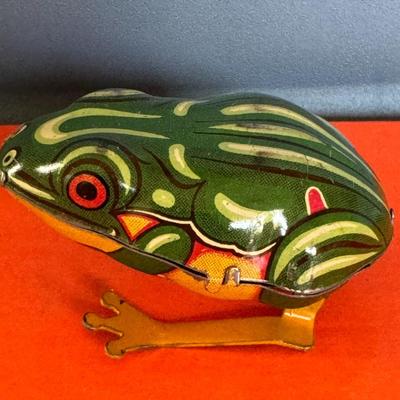
A vintage German D R G M tin frog wind-up toy, likely from the 1940s. Product Information: Name: Vintage German Tin Frog Wind Up Toy Origin: Made in Germany Era: 1940s Type: Wind-up/Clockwork mechanism tin toy Description: This charming toy is made with intricate details and features a durable and colorful design. Some models may come with a key. Function: This wind-up toy is known to jump or hop. 559 / 1369 -
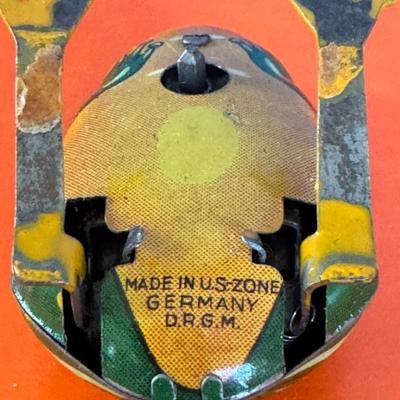
A vintage German D R G M tin frog wind-up toy, likely from the 1940s. Product Information: Name: Vintage German Tin Frog Wind Up Toy Origin: Made in Germany Era: 1940s Type: Wind-up/Clockwork mechanism tin toy Description: This charming toy is made with intricate details and features a durable and colorful design. Some models may come with a key. Function: This wind-up toy is known to jump or hop. 560 / 1369 -
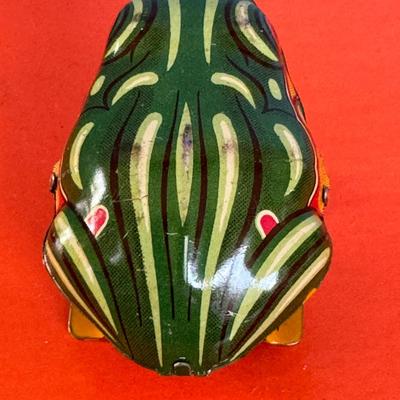
A vintage German D R G M tin frog wind-up toy, likely from the 1940s. Product Information: Name: Vintage German Tin Frog Wind Up Toy Origin: Made in Germany Era: 1940s Type: Wind-up/Clockwork mechanism tin toy Description: This charming toy is made with intricate details and features a durable and colorful design. Some models may come with a key. Function: This wind-up toy is known to jump or hop. 561 / 1369 -
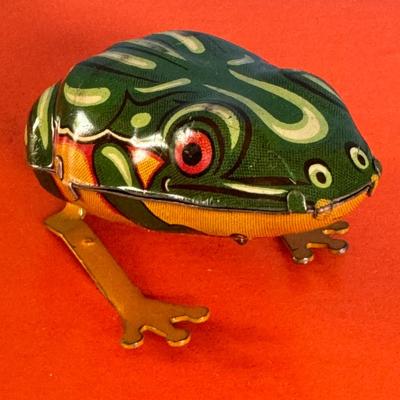
A vintage German D R G M tin frog wind-up toy, likely from the 1940s. Product Information: Name: Vintage German Tin Frog Wind Up Toy Origin: Made in Germany Era: 1940s Type: Wind-up/Clockwork mechanism tin toy Description: This charming toy is made with intricate details and features a durable and colorful design. Some models may come with a key. Function: This wind-up toy is known to jump or hop. 562 / 1369 -
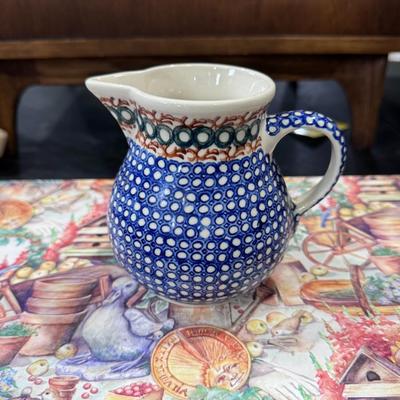
Bolesławiec Polish Pottery creamer pitcher, identifiable by its distinctive hand-painted blue and white patterns, often featuring dots or "peacock eye" motifs. This stoneware is renowned for its durability and artistic craftsmanship, originating from the Bolesławiec region of Poland. Here's more information about Polish Pottery: Handcrafted Tradition: Each piece is individually handcrafted and hand-painted by skilled artisans using techniques like hand-stamping with sponges and free-hand brushwork. Material & Durability: Made from local white clay, Bolesławiec pottery is high-fired at high temperatures with lead and cadmium-free glazes, making it exceptionally durable and resistant to chipping and scratching. It is typically safe for use in the dishwasher, microwave, oven, and freezer (with care to avoid extreme temperature changes). Symbolism: The iconic "Peacock Eye" pattern often seen in Bolesławiec pottery symbolizes prosperity, good luck, and protection. 563 / 1369 -
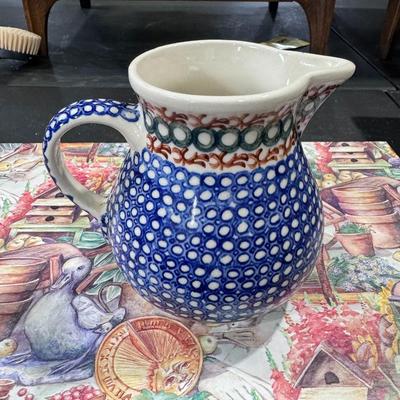
Bolesławiec Polish Pottery creamer pitcher, identifiable by its distinctive hand-painted blue and white patterns, often featuring dots or "peacock eye" motifs. This stoneware is renowned for its durability and artistic craftsmanship, originating from the Bolesławiec region of Poland. Here's more information about Polish Pottery: Handcrafted Tradition: Each piece is individually handcrafted and hand-painted by skilled artisans using techniques like hand-stamping with sponges and free-hand brushwork. Material & Durability: Made from local white clay, Bolesławiec pottery is high-fired at high temperatures with lead and cadmium-free glazes, making it exceptionally durable and resistant to chipping and scratching. It is typically safe for use in the dishwasher, microwave, oven, and freezer (with care to avoid extreme temperature changes). Symbolism: The iconic "Peacock Eye" pattern often seen in Bolesławiec pottery symbolizes prosperity, good luck, and protection. 564 / 1369 -
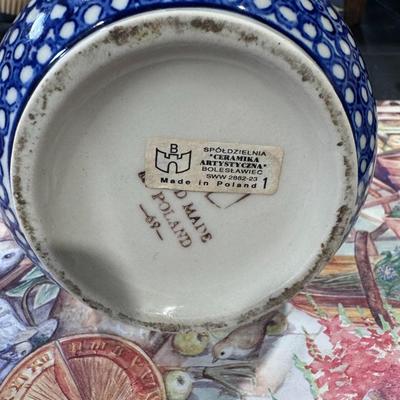
Bolesławiec Polish Pottery creamer pitcher, identifiable by its distinctive hand-painted blue and white patterns, often featuring dots or "peacock eye" motifs. This stoneware is renowned for its durability and artistic craftsmanship, originating from the Bolesławiec region of Poland. Here's more information about Polish Pottery: Handcrafted Tradition: Each piece is individually handcrafted and hand-painted by skilled artisans using techniques like hand-stamping with sponges and free-hand brushwork. Material & Durability: Made from local white clay, Bolesławiec pottery is high-fired at high temperatures with lead and cadmium-free glazes, making it exceptionally durable and resistant to chipping and scratching. It is typically safe for use in the dishwasher, microwave, oven, and freezer (with care to avoid extreme temperature changes). Symbolism: The iconic "Peacock Eye" pattern often seen in Bolesławiec pottery symbolizes prosperity, good luck, and protection. 565 / 1369 -
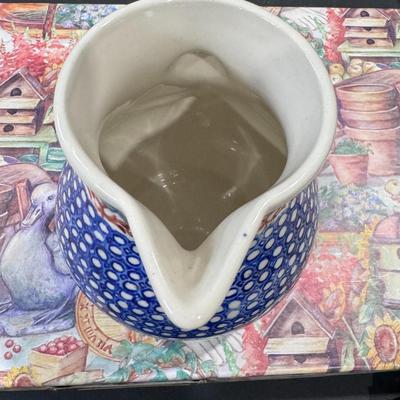
Bolesławiec Polish Pottery creamer pitcher, identifiable by its distinctive hand-painted blue and white patterns, often featuring dots or "peacock eye" motifs. This stoneware is renowned for its durability and artistic craftsmanship, originating from the Bolesławiec region of Poland. Here's more information about Polish Pottery: Handcrafted Tradition: Each piece is individually handcrafted and hand-painted by skilled artisans using techniques like hand-stamping with sponges and free-hand brushwork. Material & Durability: Made from local white clay, Bolesławiec pottery is high-fired at high temperatures with lead and cadmium-free glazes, making it exceptionally durable and resistant to chipping and scratching. It is typically safe for use in the dishwasher, microwave, oven, and freezer (with care to avoid extreme temperature changes). Symbolism: The iconic "Peacock Eye" pattern often seen in Bolesławiec pottery symbolizes prosperity, good luck, and protection. 566 / 1369 -
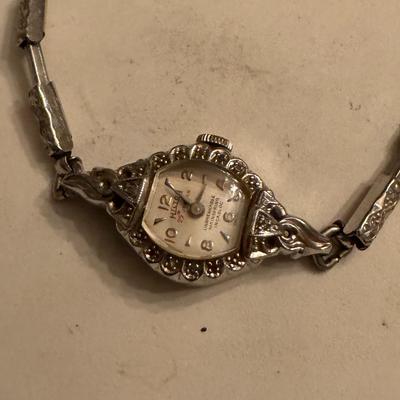
Hilton 17 Jewels watch with an "Unbreakable Mainspring" and "Incabloc" inscribed on the dial. In a mechanical watch, "17 jewels" generally indicates a "fully jeweled" movement, meaning that all important pivot points in the gear train are fitted with synthetic ruby bearings to reduce friction and improve accuracy. It's a common number of jewels for manual-wind watches. About "Unbreakable Mainspring": This term refers to a type of mainspring, the power source of the watch, which is designed with a slipping clutch mechanism to prevent overwinding and potential damage. Incabloc is a brand of shock protection system for watch movements, invented in 1934. 567 / 1369 -
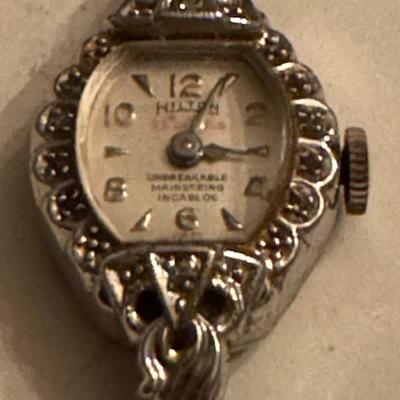
Hilton 17 Jewels watch with an "Unbreakable Mainspring" and "Incabloc" inscribed on the dial. In a mechanical watch, "17 jewels" generally indicates a "fully jeweled" movement, meaning that all important pivot points in the gear train are fitted with synthetic ruby bearings to reduce friction and improve accuracy. It's a common number of jewels for manual-wind watches. About "Unbreakable Mainspring": This term refers to a type of mainspring, the power source of the watch, which is designed with a slipping clutch mechanism to prevent overwinding and potential damage. Incabloc is a brand of shock protection system for watch movements, invented in 1934. 568 / 1369 -
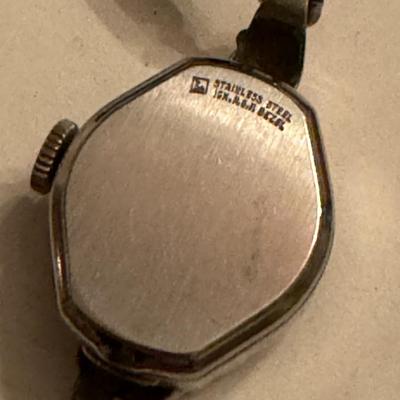
Hilton 17 Jewels watch with an "Unbreakable Mainspring" and "Incabloc" inscribed on the dial. In a mechanical watch, "17 jewels" generally indicates a "fully jeweled" movement, meaning that all important pivot points in the gear train are fitted with synthetic ruby bearings to reduce friction and improve accuracy. It's a common number of jewels for manual-wind watches. About "Unbreakable Mainspring": This term refers to a type of mainspring, the power source of the watch, which is designed with a slipping clutch mechanism to prevent overwinding and potential damage. Incabloc is a brand of shock protection system for watch movements, invented in 1934. 569 / 1369 -
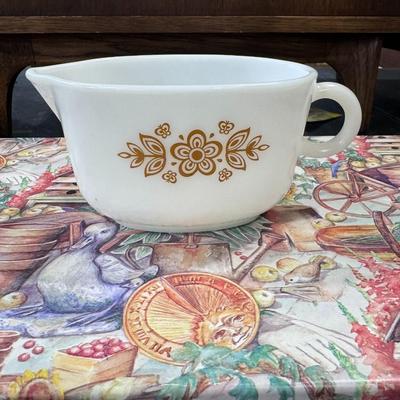
Pyrex Butterfly Gold Gravy Boat, specifically model 77B. Here's more information about this classic piece of Pyrex: Pattern and Design: The "Butterfly Gold" pattern, introduced in 1972, features a distinctive floral and butterfly motif in a golden-brown hue on a white milk glass base. The design often includes a large central flower flanked by leaves, smaller flowers, and butterflies. Production Era: This pattern was a popular staple in American kitchens during the 1970s, produced from 1972 until its discontinuation in 1981. Material and Use: Made of durable Pyrex glass, this gravy boat is designed to be oven and microwave safe, although not suitable for stovetop or broiler use. It's primarily used for serving gravy or other sauces. 570 / 1369 -
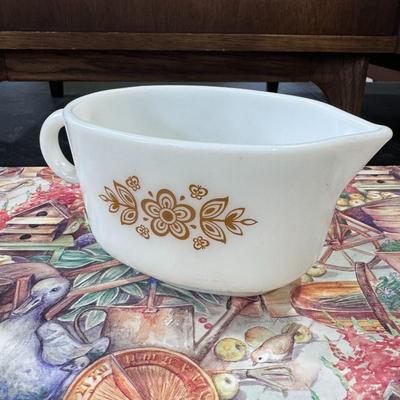
Pyrex Butterfly Gold Gravy Boat, specifically model 77B. Here's more information about this classic piece of Pyrex: Pattern and Design: The "Butterfly Gold" pattern, introduced in 1972, features a distinctive floral and butterfly motif in a golden-brown hue on a white milk glass base. The design often includes a large central flower flanked by leaves, smaller flowers, and butterflies. Production Era: This pattern was a popular staple in American kitchens during the 1970s, produced from 1972 until its discontinuation in 1981. Material and Use: Made of durable Pyrex glass, this gravy boat is designed to be oven and microwave safe, although not suitable for stovetop or broiler use. It's primarily used for serving gravy or other sauces. 571 / 1369 -
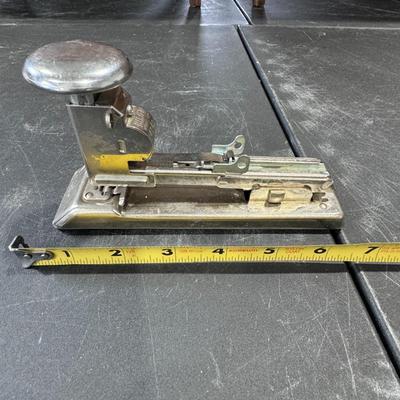
Vintage Ace Pilot Model 402 Stapler. Here's some information about this iconic office tool: Manufacturer & Origin: Produced by Ace Fastener Corp. in Chicago, USA. Design & History: The design, known for its streamline industrial aesthetic, was patented in 1930 and put into production in 1938, marking a significant improvement in stapler functionality. Features: Known for its heavy-duty, all-steel construction, the Model 402 is recognized for its durability and reliable performance, often found still in working condition decades after manufacturing. It also features an innovative two-position anvil for different stapling needs. Collectibility: As a vintage item, it is sought after by collectors and enthusiasts of mid-century modern design and office history. Variations: While the core design is consistent, variations like the Model 402-D and 404 exist within the Pilot line. 576 / 1369 -
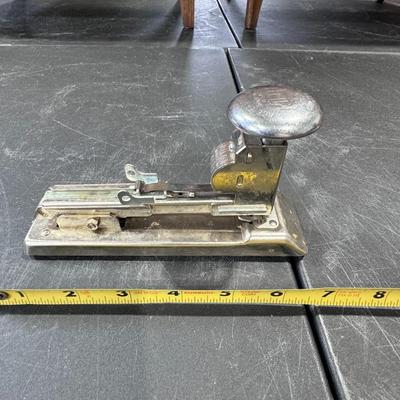
Vintage Ace Pilot Model 402 Stapler. Here's some information about this iconic office tool: Manufacturer & Origin: Produced by Ace Fastener Corp. in Chicago, USA. Design & History: The design, known for its streamline industrial aesthetic, was patented in 1930 and put into production in 1938, marking a significant improvement in stapler functionality. Features: Known for its heavy-duty, all-steel construction, the Model 402 is recognized for its durability and reliable performance, often found still in working condition decades after manufacturing. It also features an innovative two-position anvil for different stapling needs. Collectibility: As a vintage item, it is sought after by collectors and enthusiasts of mid-century modern design and office history. Variations: While the core design is consistent, variations like the Model 402-D and 404 exist within the Pilot line. 577 / 1369 -
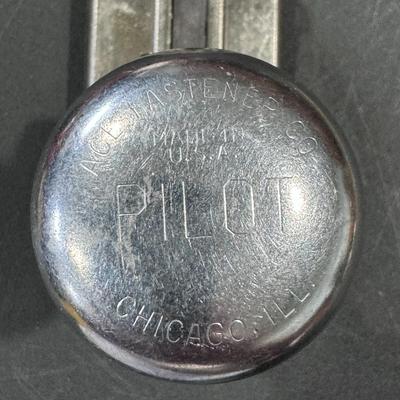
Vintage Ace Pilot Model 402 Stapler. Here's some information about this iconic office tool: Manufacturer & Origin: Produced by Ace Fastener Corp. in Chicago, USA. Design & History: The design, known for its streamline industrial aesthetic, was patented in 1930 and put into production in 1938, marking a significant improvement in stapler functionality. Features: Known for its heavy-duty, all-steel construction, the Model 402 is recognized for its durability and reliable performance, often found still in working condition decades after manufacturing. It also features an innovative two-position anvil for different stapling needs. Collectibility: As a vintage item, it is sought after by collectors and enthusiasts of mid-century modern design and office history. Variations: While the core design is consistent, variations like the Model 402-D and 404 exist within the Pilot line. 578 / 1369 -
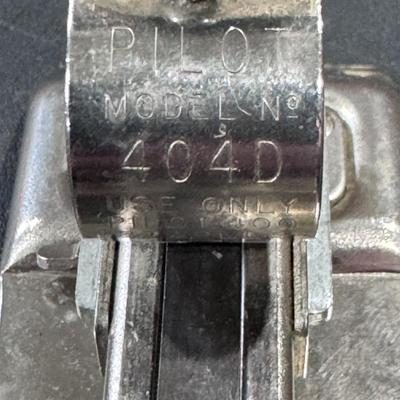
Vintage Ace Pilot Model 402 Stapler. Here's some information about this iconic office tool: Manufacturer & Origin: Produced by Ace Fastener Corp. in Chicago, USA. Design & History: The design, known for its streamline industrial aesthetic, was patented in 1930 and put into production in 1938, marking a significant improvement in stapler functionality. Features: Known for its heavy-duty, all-steel construction, the Model 402 is recognized for its durability and reliable performance, often found still in working condition decades after manufacturing. It also features an innovative two-position anvil for different stapling needs. Collectibility: As a vintage item, it is sought after by collectors and enthusiasts of mid-century modern design and office history. Variations: While the core design is consistent, variations like the Model 402-D and 404 exist within the Pilot line. 579 / 1369 -
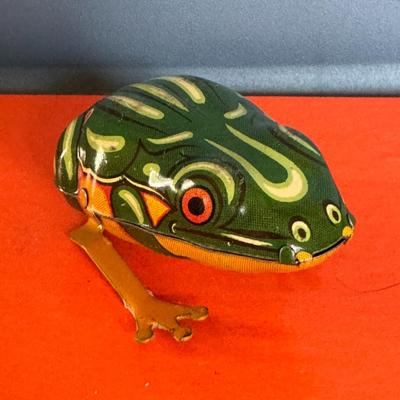
The image shows a vintage tin wind-up frog toy made in US Zone Germany in the 1940s. Key details about this type of toy: Origin: Made in the US Zone of Germany, which refers to a period after World War II when Germany was divided into zones of occupation. Markings: These toys often have a D.R.G.M. marking. This stands for Deutsches Reichs Gebrauchmuster, a German patent-like mark used for basic copyright protection, not a brand name. This marking dates the toy to 1945 or earlier, as the use of D.R.G.M. ended around that time. Some were produced slightly after 1945 but still used the D.R.G.M. marking until 1952. Mechanism: It's a wind-up toy, meaning it has a clockwork mechanism that is powered by winding a key. Note that a key may or may not be included. 580 / 1369 -
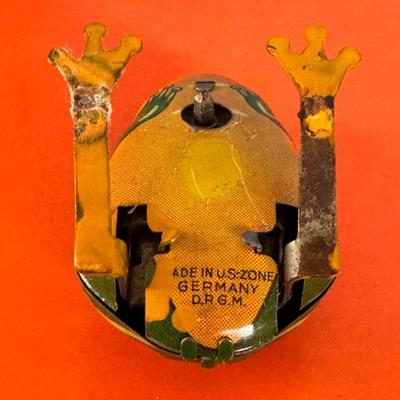
The image shows a vintage tin wind-up frog toy made in US Zone Germany in the 1940s. Key details about this type of toy: Origin: Made in the US Zone of Germany, which refers to a period after World War II when Germany was divided into zones of occupation. Markings: These toys often have a D.R.G.M. marking. This stands for Deutsches Reichs Gebrauchmuster, a German patent-like mark used for basic copyright protection, not a brand name. This marking dates the toy to 1945 or earlier, as the use of D.R.G.M. ended around that time. Some were produced slightly after 1945 but still used the D.R.G.M. marking until 1952. Mechanism: It's a wind-up toy, meaning it has a clockwork mechanism that is powered by winding a key. Note that a key may or may not be included. 581 / 1369 -
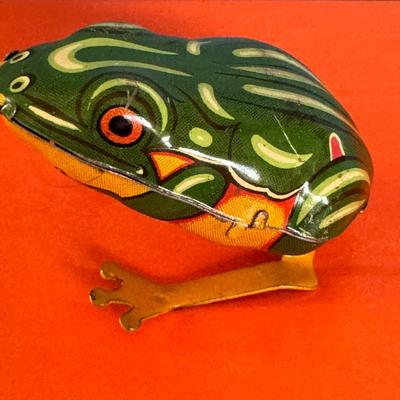
The image shows a vintage tin wind-up frog toy made in US Zone Germany in the 1940s. Key details about this type of toy: Origin: Made in the US Zone of Germany, which refers to a period after World War II when Germany was divided into zones of occupation. Markings: These toys often have a D.R.G.M. marking. This stands for Deutsches Reichs Gebrauchmuster, a German patent-like mark used for basic copyright protection, not a brand name. This marking dates the toy to 1945 or earlier, as the use of D.R.G.M. ended around that time. Some were produced slightly after 1945 but still used the D.R.G.M. marking until 1952. Mechanism: It's a wind-up toy, meaning it has a clockwork mechanism that is powered by winding a key. Note that a key may or may not be included. 582 / 1369 -
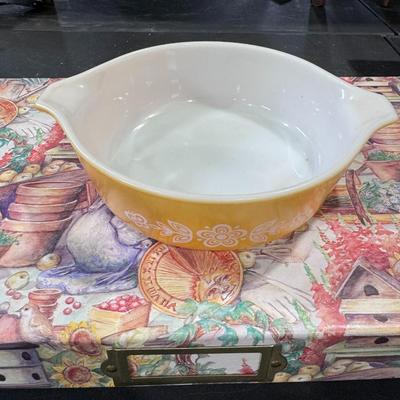
Pyrex casserole dish in the Butterfly Gold pattern. Here are some details about this iconic Pyrex item: Pattern and History: The Butterfly Gold pattern was first released in 1972 and was later reissued in 1979 with a slightly altered design. The original features a large central flower flanked by leaves, flowers, and butterflies, while the 1979 version showcases a bouquet of smaller flowers on stems. Identification: The Butterfly Gold pattern is known for its warm, buttery orange color with white designs, often featuring butterflies and five-petaled flowers. The specific piece in the image appears to be a casserole dish, possibly a 475-B which is a 2.5 quart size or similar. Vintage Distinction: Pyrex collectors often differentiate vintage pieces (made with borosilicate glass, known for its temperature change resistance) from newer ones (made with soda-lime glass) by the logo: vintage Pyrex has an all-caps "PYREX" logo, while modern Pyrex uses "pyrex" in lowercase. 583 / 1369 -
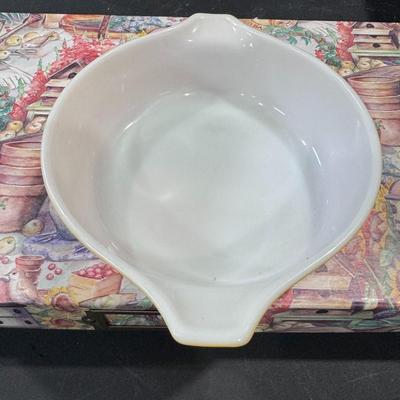
Pyrex casserole dish in the Butterfly Gold pattern. Here are some details about this iconic Pyrex item: Pattern and History: The Butterfly Gold pattern was first released in 1972 and was later reissued in 1979 with a slightly altered design. The original features a large central flower flanked by leaves, flowers, and butterflies, while the 1979 version showcases a bouquet of smaller flowers on stems. Identification: The Butterfly Gold pattern is known for its warm, buttery orange color with white designs, often featuring butterflies and five-petaled flowers. The specific piece in the image appears to be a casserole dish, possibly a 475-B which is a 2.5 quart size or similar. Vintage Distinction: Pyrex collectors often differentiate vintage pieces (made with borosilicate glass, known for its temperature change resistance) from newer ones (made with soda-lime glass) by the logo: vintage Pyrex has an all-caps "PYREX" logo, while modern Pyrex uses "pyrex" in lowercase. 584 / 1369 -
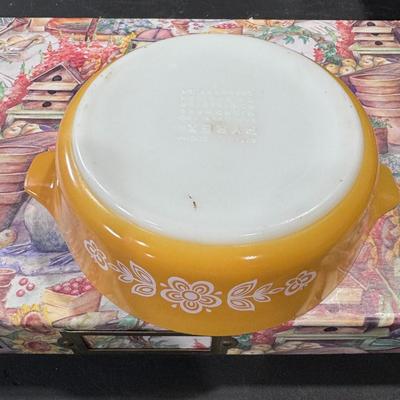
Pyrex casserole dish in the Butterfly Gold pattern. Here are some details about this iconic Pyrex item: Pattern and History: The Butterfly Gold pattern was first released in 1972 and was later reissued in 1979 with a slightly altered design. The original features a large central flower flanked by leaves, flowers, and butterflies, while the 1979 version showcases a bouquet of smaller flowers on stems. Identification: The Butterfly Gold pattern is known for its warm, buttery orange color with white designs, often featuring butterflies and five-petaled flowers. The specific piece in the image appears to be a casserole dish, possibly a 475-B which is a 2.5 quart size or similar. Vintage Distinction: Pyrex collectors often differentiate vintage pieces (made with borosilicate glass, known for its temperature change resistance) from newer ones (made with soda-lime glass) by the logo: vintage Pyrex has an all-caps "PYREX" logo, while modern Pyrex uses "pyrex" in lowercase. 585 / 1369 -
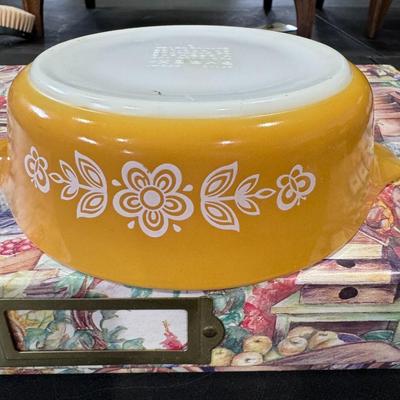
Pyrex casserole dish in the Butterfly Gold pattern. Here are some details about this iconic Pyrex item: Pattern and History: The Butterfly Gold pattern was first released in 1972 and was later reissued in 1979 with a slightly altered design. The original features a large central flower flanked by leaves, flowers, and butterflies, while the 1979 version showcases a bouquet of smaller flowers on stems. Identification: The Butterfly Gold pattern is known for its warm, buttery orange color with white designs, often featuring butterflies and five-petaled flowers. The specific piece in the image appears to be a casserole dish, possibly a 475-B which is a 2.5 quart size or similar. Vintage Distinction: Pyrex collectors often differentiate vintage pieces (made with borosilicate glass, known for its temperature change resistance) from newer ones (made with soda-lime glass) by the logo: vintage Pyrex has an all-caps "PYREX" logo, while modern Pyrex uses "pyrex" in lowercase. 586 / 1369 -
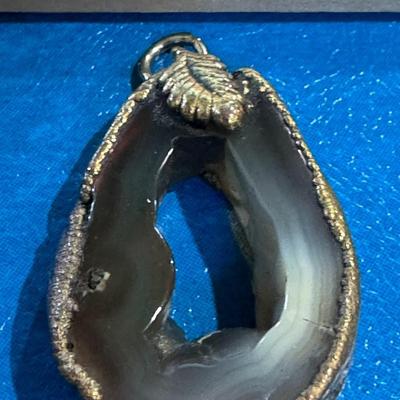
agate geode pendant, made from a polished slice of an agate geode, featuring sparkling druzy crystals within its cavity and a metallic electroplated edge and bail for use as jewelry. About the Agate Geode Pendant: Formation: Agate geodes form from volcanic processes, where lava cools around air bubbles, creating a cavity. Mineral-rich water then seeps into this cavity, and as the water evaporates over millions of years, the minerals are deposited and build up to form crystals, often quartz, creating the "druzy" effect. Appearance: The pendant showcases the natural beauty of the agate with its banding patterns and the glittering druzy crystals within the hollowed-out center. The edges are often enhanced with electroplating (like gold or silver) to create a finished look suitable for jewelry. Properties and Associations: Agate, particularly druzy agate, is often associated with properties like promoting emotional stability, reducing stress, and fostering a sense of calm. It's also linked to enhancing intuition, creativity, and self-expression, and is sometimes used in practices like meditation and energy work. 587 / 1369 -
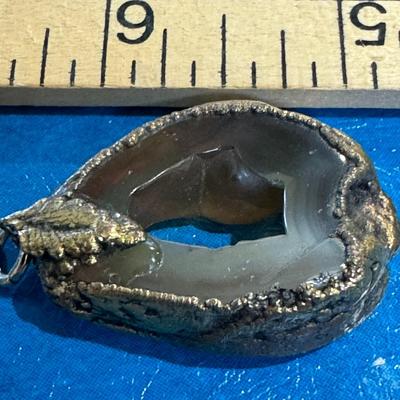
agate geode pendant, made from a polished slice of an agate geode, featuring sparkling druzy crystals within its cavity and a metallic electroplated edge and bail for use as jewelry. About the Agate Geode Pendant: Formation: Agate geodes form from volcanic processes, where lava cools around air bubbles, creating a cavity. Mineral-rich water then seeps into this cavity, and as the water evaporates over millions of years, the minerals are deposited and build up to form crystals, often quartz, creating the "druzy" effect. Appearance: The pendant showcases the natural beauty of the agate with its banding patterns and the glittering druzy crystals within the hollowed-out center. The edges are often enhanced with electroplating (like gold or silver) to create a finished look suitable for jewelry. Properties and Associations: Agate, particularly druzy agate, is often associated with properties like promoting emotional stability, reducing stress, and fostering a sense of calm. It's also linked to enhancing intuition, creativity, and self-expression, and is sometimes used in practices like meditation and energy work. 588 / 1369 -
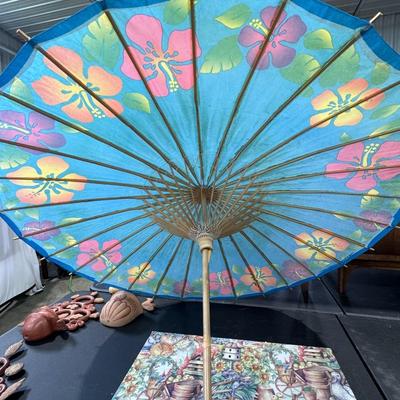
blue paper parasol decorated with hibiscus flowers, likely of Asian origin, possibly Japanese or Chinese. These parasols are traditionally crafted from materials such as bamboo and rice paper. Key details about the parasol: Design: It features hand-painted or printed hibiscus flowers in vibrant colors around the edge, consistent with tropical or Asian-inspired aesthetics. Materials: Typically made with a bamboo frame and a paper canopy, often rice paper, which provides a lightweight and decorative structure. Purpose: While visually similar to an umbrella, these paper parasols are primarily designed for sun protection and decorative use, rather than for rain, and are frequently used for events, parties, or home decor. Size: The tape measure visible in the foreground suggests the parasol has a diameter of approximately 28-30 inches based on the markings and the visual proportion to the parasol. 592 / 1369 -
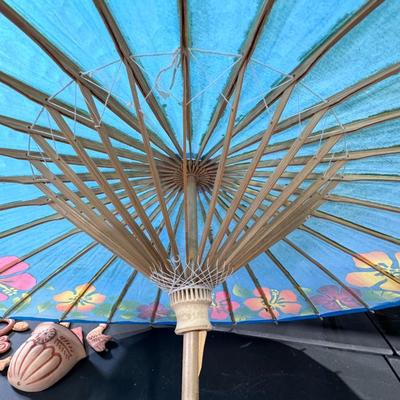
blue paper parasol decorated with hibiscus flowers, likely of Asian origin, possibly Japanese or Chinese. These parasols are traditionally crafted from materials such as bamboo and rice paper. Key details about the parasol: Design: It features hand-painted or printed hibiscus flowers in vibrant colors around the edge, consistent with tropical or Asian-inspired aesthetics. Materials: Typically made with a bamboo frame and a paper canopy, often rice paper, which provides a lightweight and decorative structure. Purpose: While visually similar to an umbrella, these paper parasols are primarily designed for sun protection and decorative use, rather than for rain, and are frequently used for events, parties, or home decor. Size: The tape measure visible in the foreground suggests the parasol has a diameter of approximately 28-30 inches based on the markings and the visual proportion to the parasol. 593 / 1369 -
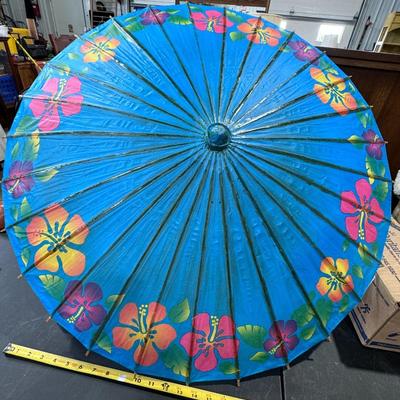
blue paper parasol decorated with hibiscus flowers, likely of Asian origin, possibly Japanese or Chinese. These parasols are traditionally crafted from materials such as bamboo and rice paper. Key details about the parasol: Design: It features hand-painted or printed hibiscus flowers in vibrant colors around the edge, consistent with tropical or Asian-inspired aesthetics. Materials: Typically made with a bamboo frame and a paper canopy, often rice paper, which provides a lightweight and decorative structure. Purpose: While visually similar to an umbrella, these paper parasols are primarily designed for sun protection and decorative use, rather than for rain, and are frequently used for events, parties, or home decor. Size: The tape measure visible in the foreground suggests the parasol has a diameter of approximately 28-30 inches based on the markings and the visual proportion to the parasol. 594 / 1369 -

blue paper parasol decorated with hibiscus flowers, likely of Asian origin, possibly Japanese or Chinese. These parasols are traditionally crafted from materials such as bamboo and rice paper. Key details about the parasol: Design: It features hand-painted or printed hibiscus flowers in vibrant colors around the edge, consistent with tropical or Asian-inspired aesthetics. Materials: Typically made with a bamboo frame and a paper canopy, often rice paper, which provides a lightweight and decorative structure. Purpose: While visually similar to an umbrella, these paper parasols are primarily designed for sun protection and decorative use, rather than for rain, and are frequently used for events, parties, or home decor. Size: The tape measure visible in the foreground suggests the parasol has a diameter of approximately 28-30 inches based on the markings and the visual proportion to the parasol. 595 / 1369 -
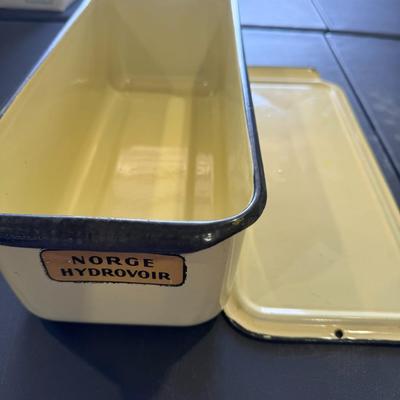
Manufacturer: Norge was a well-known appliance brand, initially a division of BorgWarner, later acquired by Magic Chef, then Maytag, and ultimately became part of Whirlpool Corporation in 2006. Purpose: These enamelware bins were commonly used in refrigerators, particularly older models, to store and keep produce crisp and fresh, functioning as an early form of a crisper drawer. Material: The "enamelware" indicates it's made of metal (likely steel or cast iron) coated with a layer of glass-like enamel, a durable and hygienic material popular in early to mid-20th-century kitchenware. 596 / 1369 -
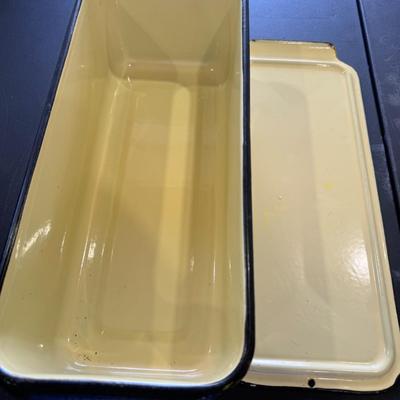
Manufacturer: Norge was a well-known appliance brand, initially a division of BorgWarner, later acquired by Magic Chef, then Maytag, and ultimately became part of Whirlpool Corporation in 2006. Purpose: These enamelware bins were commonly used in refrigerators, particularly older models, to store and keep produce crisp and fresh, functioning as an early form of a crisper drawer. Material: The "enamelware" indicates it's made of metal (likely steel or cast iron) coated with a layer of glass-like enamel, a durable and hygienic material popular in early to mid-20th-century kitchenware. 597 / 1369 -
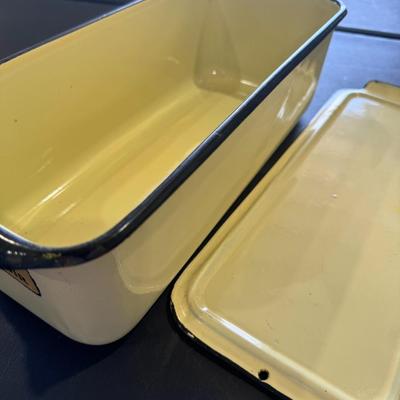
Manufacturer: Norge was a well-known appliance brand, initially a division of BorgWarner, later acquired by Magic Chef, then Maytag, and ultimately became part of Whirlpool Corporation in 2006. Purpose: These enamelware bins were commonly used in refrigerators, particularly older models, to store and keep produce crisp and fresh, functioning as an early form of a crisper drawer. Material: The "enamelware" indicates it's made of metal (likely steel or cast iron) coated with a layer of glass-like enamel, a durable and hygienic material popular in early to mid-20th-century kitchenware. 598 / 1369 -
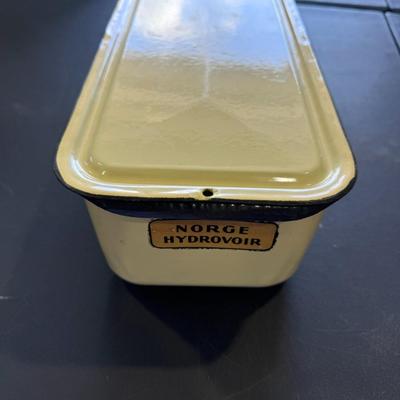
Manufacturer: Norge was a well-known appliance brand, initially a division of BorgWarner, later acquired by Magic Chef, then Maytag, and ultimately became part of Whirlpool Corporation in 2006. Purpose: These enamelware bins were commonly used in refrigerators, particularly older models, to store and keep produce crisp and fresh, functioning as an early form of a crisper drawer. Material: The "enamelware" indicates it's made of metal (likely steel or cast iron) coated with a layer of glass-like enamel, a durable and hygienic material popular in early to mid-20th-century kitchenware. 599 / 1369 -
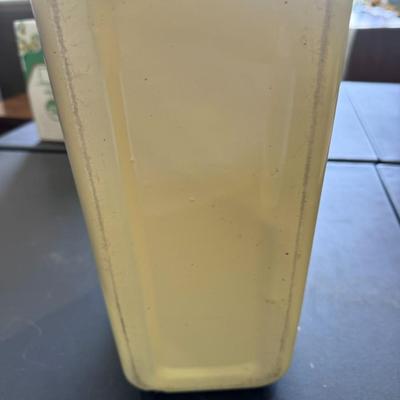
Manufacturer: Norge was a well-known appliance brand, initially a division of BorgWarner, later acquired by Magic Chef, then Maytag, and ultimately became part of Whirlpool Corporation in 2006. Purpose: These enamelware bins were commonly used in refrigerators, particularly older models, to store and keep produce crisp and fresh, functioning as an early form of a crisper drawer. Material: The "enamelware" indicates it's made of metal (likely steel or cast iron) coated with a layer of glass-like enamel, a durable and hygienic material popular in early to mid-20th-century kitchenware. 600 / 1369
Photos 501 - 600 of 1369
Per page:
